Physical Address
304 North Cardinal St.
Dorchester Center, MA 02124
Catheter-based therapies are available for a wide variety of congenital structural cardiovascular defects.
Balloon dilation provides relief of obstruction for patients with congenital pulmonary or aortic valve stenosis. This therapy may not be adequate if the valve is hypoplastic or calcified.
Congenital pulmonary artery stenosis can be effectively relieved with balloon-expandable stents; late stent redilation may be necessary in a growing child.
Coarctation of the aorta can be treated with balloon-expandable stenting; covered stents may provide an important safety advantage for older patients with a fragile aorta.
Transcatheter occlusion devices are available to safely and effectively treat a secundum-type arterial septal defect or a patent ductus arteriosus.
Transcatheter pulmonary valve replacement is effective therapy in patients who have a dysfunctional right ventricle–to–pulmonary artery conduit or a bioprosthetic pulmonary valve, as in postoperative tetralogy of Fallot.
This chapter summarizes the current state of the art of transcatheter therapy for structural congenital heart disease (CHD). It discusses catheter-based therapies that are available for some of the more common congenital defects, including semilunar valve stenosis, pulmonary artery (PA) stenosis, coarctation of the aorta, secundum atrial septal defect (ASD), and patent ductus arteriosus (PDA). New developments in transcatheter pulmonary valve replacement (TPVR) are also reviewed.
Percutaneous balloon valvuloplasty provides effective treatment in patients with congenital pulmonary or aortic valve stenosis. Surgical valvotomy for congenital semilunar valve stenosis has been replaced by these interventional catheterization techniques in most pediatric centers. Balloon-expandable stenting is standard therapy for most patients with PA stenosis. These arterial lesions often are elastic in nature—a characteristic that makes balloon angioplasty alone a less successful intervention. Coarctation stenting is an effective therapeutic intervention for selected patients with coarctation of the aorta. Transcatheter occlusion devices provide a safe, highly effective therapy for a secundum ASD or a PDA and constitute the treatment of choice for these defects. Finally, TPVR is currently routine therapy for selected patients with a dysfunctional right ventricle–to–pulmonary artery (RV-PA) conduit or bioprosthetic pulmonary valve (BPV); this remarkable new intervention can replace reoperation and is therefore an important therapeutic option for many patients.
Pulmonary valve stenosis is a common disorder, accounting for approximately 8% of congenital cardiac defects. Except for neonates with critical pulmonary stenosis, patients with untreated pulmonary valve stenosis often survive well into adulthood. However, when more than mild obstruction to right ventricular (RV) outflow is present, pulmonary valve stenosis should be relieved to prevent progression of obstruction, RV hypertrophy, myocardial fibrosis, and dysfunction. Left untreated, significant pulmonary valve stenosis eventually produces clinical symptoms such as fatigue, dyspnea, and exercise intolerance. These long-term sequelae can be avoided if pulmonary valve stenosis is treated in childhood. Nevertheless, treatment is indicated at any age if hemodynamically significant pulmonary stenosis is documented. Since its introduction in 1982 by Kan and associates, percutaneous balloon valvuloplasty has been shown to provide substantial relief of right ventricular outflow tract (RVOT) obstruction in patients with valvular pulmonary stenosis. Balloon pulmonary valvuloplasty can be performed safely and is minimally invasive. It is therefore regarded as the treatment of choice for patients with moderate to severe isolated pulmonary valve stenosis.
In congenital pulmonary valve stenosis, the valve leaflets are thickened and the commissures are fused to varying degrees. The lines of commissural fusion may appear as two or three raphes extending from the valve annulus to a small central orifice. During childhood and young adulthood, the pulmonary valve leaflets are typically supple, doming upward during systole ( Fig. 60.1 ). In older adults, pulmonary valve calcification may occur and may lead to diminished leaflet mobility. A less common form of pulmonary stenosis has been referred to as pulmonary valve dysplasia or dysplastic pulmonary valve syndrome. It often occurs as a familial trait or as part of Noonan syndrome. A dysplastic pulmonary valve is characterized by thick, cartilaginous valve leaflets with poor mobility. The pulmonary valve annulus is often hypoplastic, and there may be little or no commissural fusion.
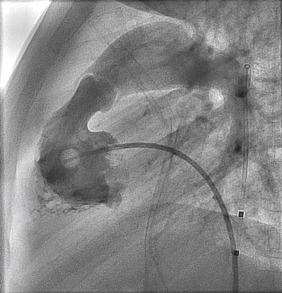
In isolated pulmonary valve stenosis, balloon dilation reduces the degree of valvular obstruction by separating fused commissures or by tearing the valve leaflets themselves. Patients with severe pulmonary valve dysplasia with hypoplasia of the annulus and absence of commissural fusion may have minimal improvement after balloon valvuloplasty. However, because a spectrum of pulmonary valve dysplasia exists, some patients with this disorder may derive substantial benefit from the balloon valvuloplasty procedure.
In contrast to balloon aortic valvuloplasty, the indications for intervention in balloon pulmonary valvuloplasty have been relatively constant over time and closely correlate with the surgical indications for valvuloplasty. In addition, the peak instantaneous pressure gradients measured by echocardiography correlate more closely with resting peak systolic gradients in the catheterization laboratory. For this reason, most physicians refer patients for catheterization and balloon valvuloplasty once the echocardiographic peak instantaneous pressure gradient is 40 mm Hg or higher or symptoms develop. The current recommendations for performing balloon pulmonary valvuloplasty are as follows :
Critical pulmonary stenosis, defined as pulmonary stenosis in a cyanotic infant requiring a PDA to provide adequate pulmonary blood flow
Resting catheterization peak systolic ejection gradient or echocardiographic peak instantaneous pressure gradient 40 mm Hg or greater
Resting catheterization or echocardiographic gradient less than 40 mm Hg in the setting of RV dysfunction or symptoms
For patients with a dysplastic pulmonary valve who meet these criteria, balloon valvuloplasty is an acceptable option, although the results may not be satisfactory, as discussed later.
Other indications for balloon pulmonary valvuloplasty that are not discussed in this text include treatment for pulmonary atresia with an intact ventricular septum but without RV-dependent coronary circulation and as a palliative procedure for patients with cyanotic CHD associated with pulmonary stenosis (e.g., tetralogy of Fallot [TOF]).
Balloon pulmonary valvuloplasty is usually performed with a percutaneous transfemoral venous approach. Right heart catheterization documents the severity of the lesion. RV angiocardiography is performed to confirm the nature of the lesion and to measure the diameter of the pulmonary valve annulus. Typically, the lateral projection is best suited to this purpose. Once the decision is made to proceed with valvuloplasty, an end-hole catheter is advanced to the left PA. The left PA provides better wire and balloon stability than a right PA position. We recommend crossing the tricuspid valve with a balloon-tipped catheter, whenever possible. This helps to prevent positioning of the catheter and wire between tricuspid valve cords and lowers the risk of tricuspid valve injury during balloon valvuloplasty. An exchange-length guidewire is advanced to the distal left PA, and the end-hole catheter is removed. The balloon valvuloplasty catheter is then inserted over the exchange wire. A balloon valvuloplasty catheter is used whose inflated balloon diameter is approximately 15% to 25% larger than the pulmonary valve annulus diameter. Balloon oversizing improves valvuloplasty effectiveness, and injury to the pulmonary valve annulus is unlikely when balloons smaller than 140% of the annulus’s diameter are used.
If the pulmonary valve annulus exceeds 25 mm or if the single-balloon catheter required is too large for safe introduction into a patient’s femoral vein, we recommend a double-balloon technique, with two balloons positioned across the valve and inflated simultaneously ( Fig. 60.2 ). The effective dilating diameter of two equal-sized balloons can be calculated based on cross-sectional area or on circumference. The sum of the balloon diameters by the circumference method is 120% of the equivalent single-balloon diameters, and by the area method it is 130%. Therefore the operator first selects the optimal single-balloon size, multiplies this diameter by 1.2 or 1.3, and then selects two balloons whose diameters are half of that product. Once inserted, the balloon valvuloplasty catheter is advanced across the valve and positioned with the valve at the midportion of the balloon. Partial balloon inflation, with a mixture of saline and contrast, is helpful to determine the precise location of the valve on the balloon. Care should be taken to avoid inflating the balloon across the tricuspid valve, which can result in tricuspid valve injury.
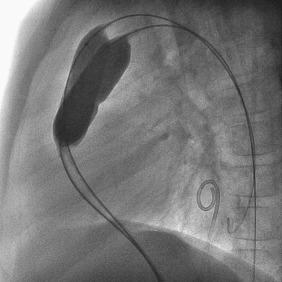
The valvuloplasty balloon or balloons are then inflated by hand until the waist produced by the valve on the balloon disappears. The period of balloon inflation is kept as brief as possible to minimize obstruction to RV outflow. Typically, three or four balloon inflations are performed with minor adjustments in balloon position to ensure adequate dilation of the pulmonary valve. After the dilation is completed, the valvuloplasty catheter is withdrawn and replaced with a diagnostic catheter. The residual RVOT gradient and cardiac output are measured to document the effectiveness of the procedure. A repeat RV angiogram may be performed if necessary to document the degree of subvalvular infundibular narrowing (which may be increased immediately after valvuloplasty) present at this point ( Fig. 60.3 ).
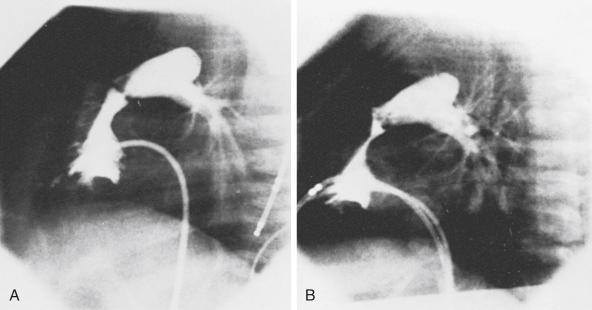
Newborns and infants with critical pulmonary stenosis or atresia are frequently critically ill and hypoxemic (because of a right-to-left atrial shunt) and may have associated hypoplasia of the RV and tricuspid valve ( Fig. 60.4 ). Because of these factors, in addition to the presence of severe RVOT obstruction, it is a technical challenge to successfully catheterize the PA and properly position a valvuloplasty balloon across the RVOT in these infants. In infants with critical pulmonary stenosis, we prefer to perform the procedure with the child receiving prostaglandin E 1 infusion, for three reasons: first, the infant is in a more stable hemodynamic state during the procedure; second, a left-to-right ductal shunt maintains pulmonary blood flow during balloon occlusion of the RVOT; and third, the presence of a PDA allows the exchange guidewire to be positioned across the pulmonary valve and into the descending aorta, a course that facilitates catheter exchanges and subsequent valve dilation.
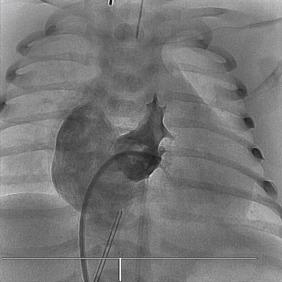
In patients with isolated pulmonary valve stenosis, percutaneous balloon valvuloplasty can be expected to provide excellent relief of obstruction ( Fig. 60.5 ). Numerous studies have clearly documented significant acute reduction in the peak systolic pulmonary valve gradient to 30 mm Hg or less (i.e., mild residual stenosis). In their landmark 1982 report, Kan and colleagues reported the acute effects of valvuloplasty in an 8-year-old child with pulmonary stenosis. The procedure decreased the peak gradient from 48 to 14 mm Hg and was performed without significant complications. Other studies have confirmed this initial observation that valvuloplasty provides impressive gradient relief acutely.
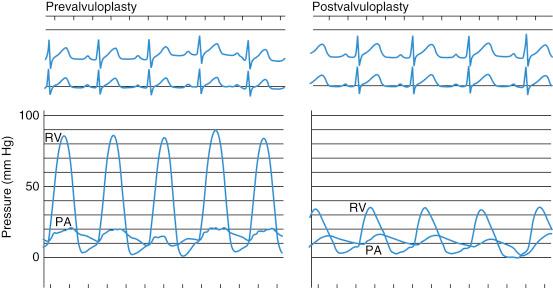
The largest published clinical series of balloon pulmonary valvuloplasty was reported by the Pediatric Valvuloplasty Registry. This registry reported the acute results of pulmonary valvuloplasty performed in 784 patients between 1981 and 1986. Overall, balloon dilation resulted in an acute decrease in the peak systolic pressure gradient from 71 to 28 mm Hg. The residual pressure gradients immediately after valvuloplasty were ascribed in part to subvalvular infundibular obstruction related to RV hypertrophy. Effectiveness of the procedure was not related to age (the series included 35 adults older than 21 years), but a larger residual gradient was observed in patients with a dysplastic pulmonary valve. The Pediatric Valvuloplasty Registry described five major complications (0.6%), primarily confined to infancy. There were two procedure-related deaths (0.2%), and in one neonate RVOT perforation and tamponade occurred. Two children developed severe tricuspid regurgitation related to injury to the tricuspid valve apparatus. Minor complications included femoral venous thrombosis, hemorrhage, and transient arrhythmias.
Several other studies have shown similar results, including data from the Congenital Cardiac Catheterization Project on Outcomes (C3PO), which included 211 cases from eight institutions between 2007 and 2010. The overall procedural success rate was 91%, with 88% of patients obtaining a reduction in the valve gradient to less than 25 mm Hg. The independent risk factors for procedural failure on multivariate analysis were the presence of supravalvular stenosis and evidence of a dysplastic pulmonary valve. Only one patient had a life-threatening adverse event (ventricular fibrillation). Although the overall rate of adverse events was 12%, most of these were mild; only 3% of patients experienced a more severe adverse event. An important finding of this study was that 6% of neonates and 2% of adults required reintervention.
Several reports have described the successful application of percutaneous balloon valvuloplasty for treatment of adults with pulmonary valve stenosis. Table 60.1 summarizes the pertinent clinical and hemodynamic data from 14 publications describing the acute results of pulmonary valvuloplasty in adolescents and adults. Pulmonary valvuloplasty has been performed successfully in patients as old as 84 years. In most published cases, a single-balloon technique has been used. However, when a 20- to 25-mm-diameter balloon was insufficient, the double-balloon technique has often been necessary.
| Study | No. of Patients | Age Range (Year) | Balloon Technique | Peak Systolic Gradient (mm Hg) | |
|---|---|---|---|---|---|
| Before | After | ||||
| Tentolouris et al. | 1 | 84 | Double | 70 | 34 |
| Herrmann et al. | 8 | 23–66 | Single | 66 | 22 |
| Sherman et al. | 4 | 48–67 | Single (3) Double (1) |
109 | 38 |
| Al Kasab et al. | 12 | 21–37 | Double | 86 | 28 |
| Fawzy et al. | 8 | 21–45 | Double | 107 | 36 |
| Flugelman et al. | 1 | 62 | Single | 260 | 90 |
| Presbitero et al. | 3 | 21–45 | Single | 130 | 29 |
| Park et al. | 3 | 24–40 | Double | 108 | 51 |
| Cooke et al. | 1 | 61 | Single | 105 | 13 |
| Leisch et al. | 6 | 21–59 | Single | 78 | 38 |
| Shuck et al. | 1 | 23 | Single | 30 | 2 |
| Pepine et al. | 1 | 59 | Single | 130 | 30 |
| Chen et al. | 53 | 13–55 | Single | 191 | 38 |
| Taggart et al. | 40 | 18–82 | Single (12) Double (8) |
54 | 22 |
In these reports, balloon valvuloplasty acutely reduced the peak systolic gradient by 60% to 65%, from a range of 53 to 260 mm Hg before the procedure to 2 to 90 mm Hg after valvuloplasty. In most cases the peak systolic gradient immediately after valvuloplasty was in the mild range (20 to 40 mm Hg). In one report, there was a significant improvement in New York Heart Association (NYHA) classification in adults 30 days after valvuloplasty. Therefore the available data clearly indicate that percutaneous balloon valvuloplasty provides effective therapy in adults as well as in children with congenital pulmonary valve stenosis. Balloon valvuloplasty appears to be effective even in the oldest patients, in whom valve calcification may be present.
Long-term studies of balloon pulmonary valvuloplasty have confirmed that the benefits of this procedure are durable and comparable to the results of surgical valvotomy. In several studies, the degree of residual stenosis remained low (<40 mm Hg, less than the current indications for intervention). In the Pediatric Valvuloplasty Registry, 16% of patients required reintervention with either repeat valvuloplasty or surgical valvotomy during a follow-up period of 8.7 years. Independent risk factors for a suboptimal late outcome included small valve annulus diameter, higher early residual gradient, smaller ratio of balloon-to-annulus diameter, and earlier year at initial intervention. This is similar to what we have found in our own long-term follow-up data.
Pulmonary insufficiency, typically mild to moderate, is a common late complication of balloon pulmonary valvuloplasty and is likely more common in smaller patients at the time of valvuloplasty. Resultant RV dilation correlates with the degree of pulmonary insufficiency. However, pulmonary valve replacement, even in patients who develop RV dilation, has typically not been required for these patients. In a study we performed comparing patients undergoing balloon valvuloplasty to an age-matched cohort of surgical patients, although the residual gradient was slightly less after surgery (16 vs. 24 mm Hg, respectively; P = .01), the surgical group had significantly more pulmonary valve insufficiency and late ventricular arrhythmias.
In one study, mild or moderate pulmonary regurgitation was associated with impaired exercise capacity, specifically lower peak oxygen consumption, when compared with lower amounts of regurgitation (85% ± 17% vs. 96% ± 16% of predicted; P = .03). In the same study, RV dilation (end-diastolic volume z score >2) was present in 40% of the study group, and the indexed end-diastolic volume of the RV correlated with the pulmonary regurgitation fraction ( R = .79; P < .001). These results suggest that relatively modest amounts of pulmonary regurgitation may result in long-term RV dilation and reduced exercise tolerance. Alternatively, these results may simply reflect the severe nature of the pulmonary stenosis in these patients before intervention and the aggressive balloon dilation procedures required: median age at intervention was 0.2 years; median RV-to-aorta pressure ratio was 110% before valvuloplasty; and median balloon-to-annulus diameter ratio was 1.3 (range 1.0 to 2.0).
Therefore late follow-up data document excellent long-term results after percutaneous pulmonary balloon valvuloplasty and support the use of this procedure as the treatment of choice for patients with isolated valvular pulmonary stenosis.
Beyond infancy, percutaneous balloon pulmonary valvuloplasty is a very safe procedure. In the Pediatric Valvuloplasty Registry, the only two deaths occurred in infants with critical pulmonary stenosis, and the single case of perforation and tamponade occurred in an 8-day-old neonate. Minor complications were primarily related to vascular injury or hemorrhage and were also much more common during the first 12 months of life. Overall, the Pediatric Valvuloplasty Registry reported a 1.2% to 1.8% frequency of major complications and a 4.8% frequency of minor complications in 168 infants. In contrast, in 656 children and adults, the frequency of major complication was 0.8% and the frequency of minor complication was 1.7%.
In the C3PO study of 211 balloon pulmonary valvuloplasty procedures in the current era across several institutions, the overall adverse event rate was 12%, and most of these (79%) were of low severity. Again, neonates were more likely to experience adverse events (19% vs. 6%). In the overall cohort, the most common type of adverse event was transient arrhythmias and conduction abnormalities, which were seen in 5% of patients.
There have been no reports of long-term arrhythmias after valvuloplasty. Valvuloplasty may cause injury to the femoral vein, especially when the procedure is performed in infancy. As discussed earlier, the mild pulmonary valve insufficiency commonly seen after pulmonary valvuloplasty, although perhaps not entirely benign, is rarely of clinical importance and may be less severe than after surgical valvotomy.
Percutaneous balloon pulmonary valvuloplasty is the treatment of choice for children and adults with isolated congenital valvular pulmonary stenosis. Valvuloplasty successfully reduces significant RVOT obstruction, with a residual gradient that is usually in the trivial to mild range (i.e., <30 mm Hg). Follow-up studies have documented long-term effectiveness, with little restenosis. Late pulmonary insufficiency is common and may cause RV dilation, but need for pulmonary valve replacement is atypical. Pulmonary valvuloplasty is indicated in neonates with critical pulmonary stenosis and in patients of any age with isolated pulmonary valve stenosis whose resting peak systolic pressure gradient exceeds 40 mm Hg in the presence of a normal cardiac output.
Aortic valve stenosis accounts for 4% to 6% of all cases of CHD. Left ventricular (LV) outflow tract obstruction elicits LV hypertrophy and myocardial fibrosis, which may eventually lead to LV dysfunction and congestive heart failure. Unlike most cases of congenital pulmonary valve stenosis, congenital aortic stenosis tends to progress over time.
Successful percutaneous balloon valvuloplasty in children with congenital aortic valve stenosis was first reported in 1984 by Lababidi and colleagues. Balloon valvuloplasty typically reduces the LV outflow tract obstruction to the mild range, and at most centers, it is the treatment of choice for children with congenital aortic stenosis who require intervention. In the past 30 years, there have been a few changes to the technique but considerable debate on the indications for percutaneous intervention.
The current recommended indications for aortic valvuloplasty reflect the 2011 scientific statement from the American Heart Association. The gradient criteria listed are resting peak systolic gradients measured in the catheterization laboratory with the patient sedated. Extrapolation to echocardiogram-derived Doppler peak instantaneous pressure gradients or mean gradient is not reliable, especially in the setting of aortic insufficiency. In addition, given the impact of general anesthesia on systemic blood pressure, resting gradients should be obtained under light conscious sedation whenever possible.
Aortic balloon valvuloplasty is indicated for infants with critical aortic stenosis, which is defined as isolated aortic stenosis with either depressed LV systolic function or evidence of ductal dependency to maintain adequate cardiac output. Infants with critical aortic stenosis typically have severe congestive heart failure and shock with profound LV dysfunction ( Fig. 60.6 ). Notably, the gradient across the aortic valve does not reflect the degree of aortic stenosis because of poor ventricular function and low anterograde flow across the aortic valve.
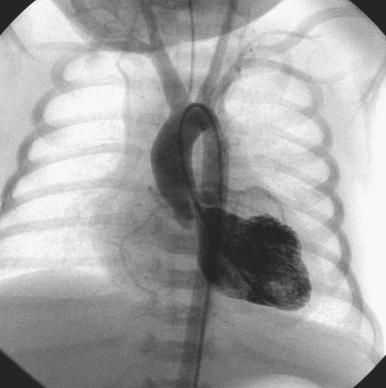
In isolated valvular aortic stenosis, aortic balloon valvuloplasty is indicated in children with either of the following:
Resting peak systolic gradient 50 mm Hg or greater
Resting peak systolic gradient 40 mm Hg or greater if there are any symptoms (e.g., anginal chest pain, syncope) or ischemic changes on either resting or exercise electrocardiography (ECG)
Less well-established indications are:
Resting peak systolic gradient 40 mm Hg or greater without symptoms or ischemic ECG changes in a patient who plans to become pregnant or to participate in competitive sports
Resting peak systolic gradient less than 50 mm Hg in heavily sedated or anesthetized patients if the echocardiographically derived mean gradient is more than 50 mm Hg
Aortic valvuloplasty is not indicated in patients with a resting peak systolic gradient of less than 40 mm Hg who are without symptoms or ischemic ECG changes, nor in patients with severe insufficiency who have a surgical indication for aortic valve repair or replacement.
Percutaneous aortic valvuloplasty is usually performed from a retrograde transarterial approach, although the antegrade transseptal approach can also be used. In infants, alternative approaches include the carotid artery and the umbilical artery (see later discussion). We prefer the retrograde approach and use a transseptal catheter for continuous LV pressure monitoring throughout the procedure. After the transseptal puncture is accomplished, heparin is administered to increase the activated clotting time (ACT) to approximately 250 to 300 seconds. The aortic stenosis gradient is measured before angiography, with simultaneous ventricular and aortic pressure recordings. Alternatively, a single catheter with both end and side holes can be used to simultaneously measure the LV and aortic pressures. Aortic root and LV angiography are helpful to determine the baseline aortic insufficiency and measure the aortic valve annulus.
Once the decision has been made to proceed with balloon valvuloplasty (see indications described previously), a balloon with the proper diameter is chosen. This diameter is based on the aortic valve annulus diameter, which can be measured by echocardiography or by angiography. Typically, the balloon diameter is 90% to 100% of the aortic valve diameter. Unlike pulmonary balloon valvuloplasty, oversized balloons are not used for aortic valvuloplasty because they have been shown to increase the risk of injury to the aortic valve and annulus. The single-balloon technique, as opposed to the double-balloon technique (which requires two arterial access points) is chosen primarily after consideration of the femoral arterial size to minimize the risk of femoral arterial injury. In our experience, a double-balloon technique is rarely needed until the aortic annulus is larger than 25 mm.
The balloon or balloons are inflated until the waist produced on the balloon by the valve is relieved ( Fig. 60.7 ). Balloon inflation is kept as brief as possible to minimize arterial hypotension during the procedure. To minimize balloon movement during inflation, which has been suggested to cause increased aortic insufficiency during valvuloplasty, rapid ventricular pacing may be performed via a venous access site to temporarily lower stroke volume. A recent randomized trial comparing results of valvuloplasty with or without rapid ventricular pacing in older adults with degenerative aortic valve disease did not demonstrate any immediate difference in the degree of aortic insufficiency. This study did not examine late postvalvuloplasty aortic insufficiency, and owing to the specific population studied, it does not necessarily inform the practice of routine balloon aortic valvuloplasty in children and young adults. After valvuloplasty, repeat measurements of LV and aortic pressures and aortic root angiography are performed to quantify the residual aortic stenosis gradient and degree of resultant aortic insufficiency.
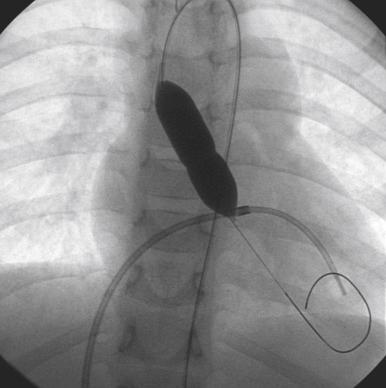
In newborns with critical aortic stenosis, prostaglandin E 1 infusion is initiated to maintain patency of the ductus arteriosus and support cardiac output. Intravenous inotropic support, and occasionally extracorporeal membrane oxygenation support, may be required to stabilize the patient before the procedure. Often, a transumbilical approach ( Fig. 60.8 ) is used to spare the infant’s femoral artery (which may be required for future percutaneous valve dilation procedures).
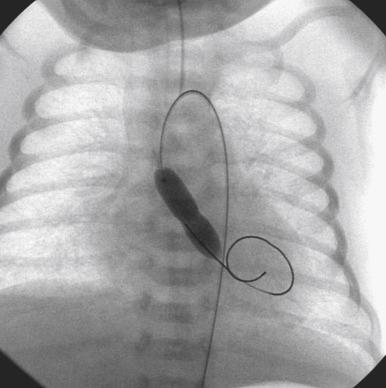
The carotid artery and transvenous antegrade approaches have also been reported as means to avoid femoral artery injury in small infants. The carotid approach can be accomplished by a cutdown procedure or by percutaneous access with ultrasound guidance. This route provides a relatively direct access to the aortic valve and is especially useful in low birth weight neonates with critical aortic stenosis. A single-balloon technique is used with a single inflation. In contrast, McElhinney and colleagues reported starting with smaller balloons and performing serial dilations with progressively larger balloons until the desired degree of relief was obtained.
Rapid ventricular pacing is not necessary to stabilize the balloon during inflation given the depressed LV function. The most challenging aspect of the procedure is often crossing the aortic valve. Special care must be taken to avoid perforation of an aortic valve leaflet (by crossing with a very soft wire), because severe aortic insufficiency due to leaflet tear is poorly tolerated.
Become a Clinical Tree membership for Full access and enjoy Unlimited articles
If you are a member. Log in here